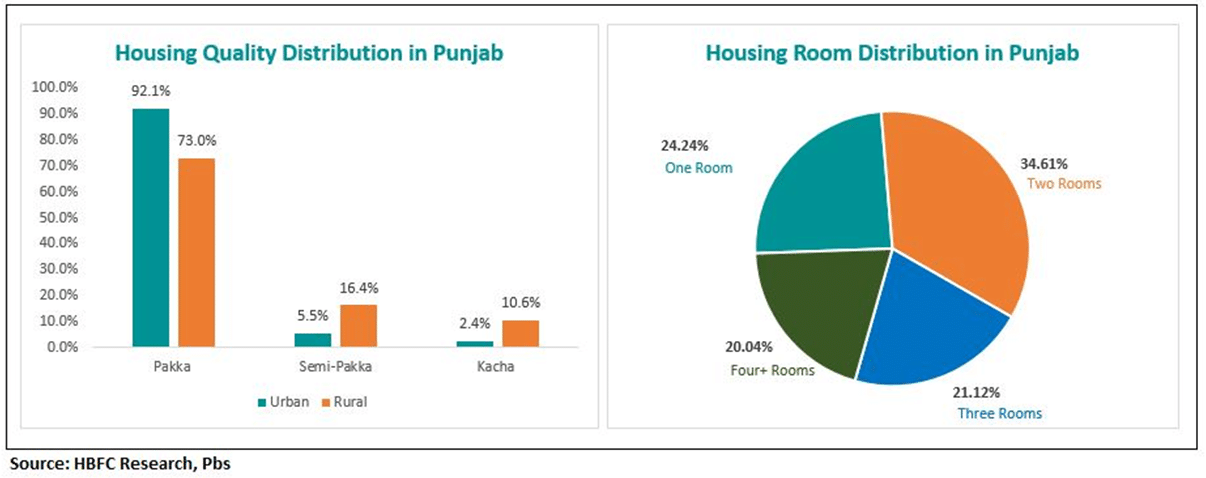Demographic Pressures and Housing Demand
Punjab faces significant housing challenges driven by its substantial population of 127.7 million and a high population density of 621.83 persons per square kilometer. The province’s annual growth rate of 2.53% is intensified in urban areas, which are expanding at 4.24% – nearly triple the rural growth rate of 1.46%. With 40.71% of the population in urban areas, this accelerated urbanization is creating unprecedented pressure on housing infrastructure. The average household size of 6.4 members (6.3 in urban and 6.4 in rural areas) further amplifies the demand for adequate housing space.
Employment Patterns and Household Economics
The employment-to-household size ratio reveals critical affordability challenges across income quintiles. Urban households in the lowest quintile face particular pressure, supporting approx 8 members with only approx 2 employed individuals, while rural counterparts maintain approx 7 members with approx 2 employed persons. This employment pattern significantly impacts housing affordability, as higher quintiles show lower household sizes but also fewer employed members (dropping to 1.41 in the fifth quintile). The economic implications are evident in household incomes, with urban areas averaging PKR 118,995 monthly versus rural areas’ PKR 76,390. Notably, even with these income disparities, Punjab shows positive savings across all quintiles, ranging from PKR 4,174 in urban first quintile to PKR 27,527 in urban fifth quintile.
Housing Quality and Distribution
The housing stock of 19.84 million units shows significant quality variations. Urban areas demonstrate higher quality housing with 92% Pakka structures, while rural areas maintain 73% Pakka houses. The presence of 1.44 million Kacha houses (7.3% of total stock) indicates a persistent need for housing quality improvement. Ownership patterns reveal that 84.3% of houses are owner-occupied, though female ownership remains low at 4.1%. Room distribution analysis shows 24.2% single-room dwellings, 34.6% two-room houses, 21.1% three-room accommodations, and 20% with four or more rooms, highlighting varying levels of spatial adequacy across households.

Affordability Metrics and Financial Burden
Housing affordability in Punjab shows complex patterns across regions and income groups. Urban households face a higher housing cost burden at 23.7% of income compared to 16.7% in rural areas. The rent burden is particularly pronounced in urban areas (17.57%) versus rural regions (8.68%). The median house price of PKR 2.92 million (first quintile) results in monthly mortgage payments of PKR 29,955 at the current prevailing interest rate. The Housing Affordability Index (HAI) of 0.9 indicates that median household income (PKR 1.11 million annually) approaches but falls short of the qualifying income (PKR 1.20 million) required for mortgage financing. Price-to-income ratios vary significantly, ranging from 4.96 in the first quintile to 7.26 in the third quintile, before moderating to 6.15 in the fifth quintile.

Housing Policy Framework, Current Initiatives and Development Pathways
In response to these challenges, the Punjab government’s implementation of the Apni Chhat Apna Ghar Program and World Bank-funded Punjab Affordable Housing Program (PAHP) marks significant steps toward addressing housing affordability. These initiatives, coupled with PMIU’s efforts to enhance housing institutions and expand affordable housing options through private sector engagement, demonstrate a multi-faceted approach to the housing crisis. However, the success of these programs will depend heavily on their implementation and alignment with market realities. Given the current HAI of 0.9 and varying housing cost burdens across urban (23.7%) and rural (16.7%) areas, future policy interventions should focus on innovative financing mechanisms, including graduated payment mortgages, shared equity schemes, and rent-to-own programs. Additionally, the government should consider establishing a dedicated housing microfinance facility targeting households in the lower income quintiles, potentially incorporating Islamic financing principles to increase accessibility. The integration of green building standards and climate-resilient infrastructure into these initiatives could also help reduce long-term housing costs while promoting environmental sustainability. Furthermore, specific attention must be paid to addressing the gender disparity in housing ownership, with only 4.1% female ownership, through targeted programs offering preferential terms for women homeowners. These comprehensive policy measures, combined with continued monitoring of affordability metrics and housing quality indicators, will be crucial in creating a more inclusive and sustainable housing market in Punjab. Moreover, it is pertinent to mention that the HAI of Punjab is better than other provinces in Pakistan.
